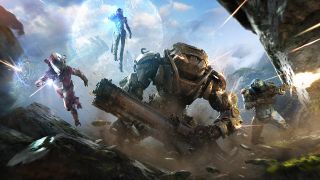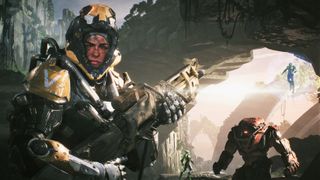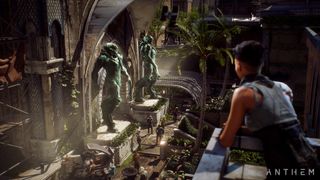How Fortnite's cube is inspiring Anthem's post-launch plans
BioWare's producers talk about the 'spice' Epic adds to seasonal content to keep players engaged.

Fortnite doesn't even need a story. A multiplayer battle royale game only needs people to play it, but when the closure of a time rift in the sky summoned a massive purple cube that’s been rolling over the map, burning runes into the ground and leaving behind low-gravity bubbles, the innumerable Reddit threads and YouTube videos promoted more discussion than any videogame story since Mass Effect 3’s contentious ending.
Now imagine the whirlwind of speculation applied to a live event taking place in a game with people and places you (hopefully) care about. Aiming to take the studio’s famous storytelling to a shared world, BioWare executive producer Mark Darrah and lead producer Mike Gamble cited Fortnite's cube when I chatted with them at PAX West about their post-launch plans for Anthem.

What we’ve never had before is the ability to have a shared experience we can all talk about and have storytelling on this communal level.
Mark Darrah
“Well one problem that we’ve had with BioWare games is there’s a real reluctance to talk about what you’ve experienced because of the feeling of spoilers,” says Darrah. “But when you look at something like Fortnite, there’s this very shared communal storytelling going on, like with the purple cube or the missile or the meteor showers. People share this experience because they know everyone saw it. That’s what our world actually gets us. What we’ve never had before is the ability to have a shared experience we can all talk about and have storytelling on this communal level.”

What's new with the latest Fortnite season
The best Fortnite creative codes
The optimal Fortnite settings
Our favorite Fortnite skins
The best Fortnite toys
Like Fortnite, they’re starting with a malleable world that suits on-going surprising narratives of every size (and shape).
“It’s cool because the world fiction and the IP is all build around this, right?” says Gamble. “You have this incredible force that no one can really quantify that just basically is just ripping the world and changing it and creating new disgusting creatures and different things.”
Gamble’s referring to the Anthem of Creation, ancient technology left behind by an advanced race use to create and modify worlds. Ancient tech from an ancient race is a BioWare cliché at this point, but it’s necessary for Anthem’s future. Anthem is, in every sense, designed for world-building.

But as was the case with Destiny 2, players inherently burn through updates faster than they can be created. Maintaining an efficient development pipeline that keeps up with the quickly waning interests of its players is a gargantuan effort, but Darrah tells me they won’t make the same mistakes as other live games, once again pointing to Epic for reference.
PC Gamer Newsletter
Sign up to get the best content of the week, and great gaming deals, as picked by the editors.
“So we definitely are planning to do some seasonal content, bigger stuff. But then I think we need something more than that. I think what Fortnite, what Epic has done that others maybe haven’t figured out, is that they have seasons—big 10 week-long things—and then within that they’re like, we’re just going to sprinkle in something on top of that,” says Darrah. They’re dead set on avoiding droughts, and say they might even do live storytelling more often than Epic is in Fortnite.
“What then you see is a lot of developers are missing is that second level of thing,” says Darrah. “They’ve got the season and they hit that cadence. ‘We do five things a year, six things a year.’ But they don’t have that extra little bit of spice, and that’s what Epic has figured out.”
“We have a full plan. Potentially even a third layer,” adds Gamble. “We understand completely that as time goes on people’s interest in things will drop off and then the only people you’ll be able to get back are the ones who are super hardcore in the game. We don’t want that.”

Epic’s Fortnite spice so far has arrived in the form of a meteor shower, a missile launch that broke open the space-time continuum on a live server, and most recently, the massive purple cube’s wayward march across the map. Darrah and Gamble are reluctant to detail exactly how their layered post-launch narrative updates will manifest in Anthem—that would mean spoiling the base game—but they’re looking to what they’re renowned for as a starting point: character.
Anthem is its own thing. Anthem is not Dragon Age or Mass Effect.
Mike Gamble, Lead Producer
Darrah tells me, “We can have one of the characters you’re already interacting with be like, ‘Oh, you know I heard about a big purple cube!’ And then you show the big purple cube, and then the big purple cube moves, and then oh my God, the big purple cube is whatever the hell the big purple cube is going to be.”
“And we can do that without the players waiting for five, six, three, four, whatever months for massive DLC,” adds Gamble. Larger releases of story-based DLC are still promised, and they’ll all be free, but between them will be these connective events.
A shared story is a major change for BioWare, and a risky one at that. Darrah and Gamble are aware they might be alienating fans who prefer personal authorship over every inch of their world, but they’re ready to expand what players expect from BioWare. “Anthem is its own thing. Anthem is not Dragon Age or Mass Effect,” says Gamble.
Fort Tarsis, a singleplayer hub filled with characters and vendors players explore on their lonesome between missions, could scratch that choice-and-consequence itch players still want from BioWare anyway. Cordoned off from the events in the shared world players will zip about in their javelins together, Fort Tarsis is where you’ll build (or break) relationships with the locals. While who you choose to make friends and enemies of won’t—can’t—determine the fate of the shared world, Darrah doesn’t believe that matters.
“When you go and look at the moment of agency that really people remember from previous BioWare games, they aren’t the earth-shattering ones. They’re the personal ones, the ones that impacted people that you cared about.”

Players may not be able to change the course of history on their own in Anthem, which leaves BioWare’s live team behind the steering wheel—a team prepared to make those earth-shattering changes on behalf of everyone, sometimes according to goals or conditions that players will need to respond to in unison.
“We lose the ability for you to say ‘I’m going to push this button and that mountain over there is going to explode.’ We as developers can decide to blow that mountain up because you guys all didn’t kill enough Scars, and then that’s a thing we can experience together, the consequence of that,” says Darrah. “And I think that’s amazing, but from a personal agency perspective the story choices that really matter are like ‘I didn’t help this person and now they’re dead.’ ... We can diverge there because that’s the kind of thing and impact that I see reflected back at me in my version of Tarsis, and you see in your version your version of Tarsis. But when we’re out in the world, the world doesn’t care. It doesn’t care about that. I care, but the world is impassive to that.”
But the world won’t be quiet. If BioWare can keep pace with the likes of Epic’s wild Fortnite stories, then Anthem could become one of the most fascinating live games yet. We'll be able to try BioWare's first shared-world shooter out when it gets a demo in February, and it'll release that month, on February 22.
To cap things off, I ask them what color Anthem’s sentient cube will be. They laugh, but tell me lavender. A gentle shade of lavender.
James is stuck in an endless loop, playing the Dark Souls games on repeat until Elden Ring and Silksong set him free. He's a truffle pig for indie horror and weird FPS games too, seeking out games that actively hurt to play. Otherwise he's wandering Austin, identifying mushrooms and doodling grackles.
Most Popular



